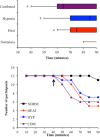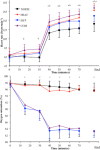The impact of submaximal exercise during heat and/or hypoxia on the cardiovascular and monocyte HSP72 responses to subsequent (post 24 h) exercise in hypoxia
- PMID: 25343025
- PMCID: PMC4179935
- DOI: 10.1186/2046-7648-3-15
The impact of submaximal exercise during heat and/or hypoxia on the cardiovascular and monocyte HSP72 responses to subsequent (post 24 h) exercise in hypoxia
Abstract
Background: The aims of this study were to describe the cellular stress response to prolonged endurance exercise in acute heat, hypoxia and the combination of heat and hypoxia and to determine whether prior acute exposure to these stressors improved cellular tolerance to a subsequent exercise bout in hypoxia 24 h later.
Methods: Twelve males (age 22 ± 4 years, height 1.77 ± 0.05 m, mass 79 ± 12.9 kg, VO2 max 3.57 ± 0.7 L · min(-1)) completed four trials (30-min rest, 90-min cycling at 50% normoxic VO2 max) in normothermic normoxia (NORM; 18°C, FIO2 = 0.21), heat (HEAT; 40°C, 20% RH), hypoxia (HYP; FIO2 = 0.14) or a combination of heat and hypoxia (COM; 40°C, 20% RH, FIO2 = 0.14) separated by at least 7 days. Twenty-four hours after each trial, participants completed a hypoxic stress test (HST; 15-min rest, 60-min cycling at 50% normoxic VO2 max, FIO2 = 0.14). Monocyte heat shock protein 72 (mHSP72) was assessed immediately before and after each exercise bout.
Results: mHSP72 increased post exercise in NORM (107% ± 5.5%, p > 0.05), HYP (126% ± 16%, p < 0.01), HEAT (153% ± 14%, p < 0.01) and COM (161% ± 32%, p < 0.01). mHSP72 had returned to near-resting values 24 h after NORM (97% ± 8.6%) but was elevated after HEAT (130% ± 19%), HYP (118% ± 17%) and COM (131% ± 19%) (p < 0.05). mHSP72 increased from baseline after HSTNORM (118% ± 12%, p < 0.05), but did not increase further in HSTHEAT, HSTHYP and HSTCOM.
Conclusions: The prior induction of mHSP72 as a result of COM, HEAT and HYP attenuated further mHSP72 induction after HST and was indicative of conferred cellular tolerance.
Keywords: Cross-acclimation; Cycling; Humans; Preconditioning.
Figures






References
-
- Horowitz M. In: Progress in Brain Research. Volume 162. Sharma HS, editor. ᅟ: Elsevier; 2007. Heat acclimation and cross-tolerance against novel stressors: genomic–physiological linkage; pp. 373–392. - PubMed
LinkOut - more resources
Full Text Sources
Other Literature Sources
Miscellaneous

